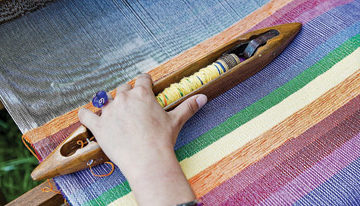Exquisite Indian Handmade Carpets are not only part of luxurious lifestyle in modern times but also reflect timeless amalgamation of nature, culture and art from the world over. The art of carpet weaving in India was introduced by Sultan Zain-ui-Abadin, who brought some Persian carpet weavers into Kashmir in the fifteenth century to train the local inhabitants. It however, flourished here only after 1,535, during the reign of Mughal emperor Humayun and his successors.
Today, the exquisite masterpieces created by over 2 mn Indian Carpet Weavers and Craftsmen, mostly expert artisans, continue to enchant the consumers the world over. Indian carpets are known for their magnificent designs, intricate patterns, vivid colours and matchless craftsmanship. No wonder, India has emerged as the largest exporter of handmade carpets in the world with a 34 per cent share of the global markets, reflecting their immense popularity and acceptability.
About Carpet Export Promotion Council
The Carpet Export Promotion Council (CEPC) was set-up by Ministry of Textiles in the year 1982 under Companies Act to Support, Protect, Maintain, increase and promotes the export of handmade Carpets and other floor covering from India. There is 2,600 member – exporters registered with this Council under the Import Export Policy. The main functions and objectives of this Council are to organize participation in trade fairs, exhibitions and Buyer Seller Meets in India and abroad.
To work for total eradication of illegal Child Labour from Handmade Carpet Industry and for the Welfare of the weavers. To advise Govt. and other appropriate authorities on the Policies adopted by the issues related to exports of Handmade Carpets and other floor coverings. To build a statistical base and provide data on the exports and imports of the country, as well as other relevant international trade data. To conduct publicity campaign for branding Indian Carpets.
Inside of Indian Handmade Carpet Industry
Highly Labour intensive, provides employment to 2 (Two) mn weavers/person directly or indirectly. 85-90 per cent is exported out of the total production. Exports increased from Rs. 4.42 cr in 1961-62 to Rs. 9,336.59 cr in 2017-18. Gained No.1 Status in terms of Value and Quantity in Exports of Handmade carpets.

Committed to Hon’ble Prime Minister’s vision of “Make in India” with Zero Defect and Zero Effect.
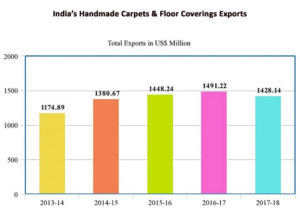 India is a world leader in export of handmade carpets and other floor coverings. Ranked No. 1 as a producer and exporter of Handmade Carpets and other Floor Coverings both in terms of volume and value. It provides extra and alternate occupation to the farmers and others at their homes especially women.
India is a world leader in export of handmade carpets and other floor coverings. Ranked No. 1 as a producer and exporter of Handmade Carpets and other Floor Coverings both in terms of volume and value. It provides extra and alternate occupation to the farmers and others at their homes especially women.
Artisans can make handmade carpets in any design, colour and quality as per the needs of overseas buyers and also caters to the requirement of every segment of the society. India produces wide range of handmade carpets and other floor covering in low, medium and high qualities for all the segments of consumers.
Product delivery time is the fastest. Raw-materials used are diverse and bending & mixing of different yarns is its speciality. It produces wide range of designs based on its rich cultural heritage, traditions, history and develops modern designs on country based requirements.
Major carpet producing Centres in India
Uttar Pradesh (UP) – Major Craft Centres – Bhadohi, Mirzapur, Varanasi, Agra Other Craft Centres – Sonbhadra, Saharanpur, Sahajanpur Jaunpur, Hathras, Ghaziabad etc. Jammu & Kashmir (J&K) – Major Craft Centres – Srinagar, Baramullah, Pulwama, Anantnag Other craft Centres – Pandipura, Badgam, Leh Kupwara, Pattan, Kanihama etc. Rajasthan – Major Craft Centres – Jaipur Other craft Centres – Tonk, Bikaner, Jodhpur and surrounding areas, Alwar etc. Haryana – Major Craft Centres – Panipat Other craft Centres – Sonepat, Karnal Punjab – Major Craft Centres – Amritsar Other craft Centres – Ambala, Pathankot Himachal Padresh (HP) – Major Craft Centres – Dharamshala Other craft Centres – Manali, Mandi etc. Gujarat – Major Craft Centres – Baruch Other craft Centres – Surat Kerala – Major Craft Centres – Karur Sikkim – Major Craft Centres – Gangtok Other craft centres – Ranipool, Tadong, Lachen & Lachung Manipur – Major Craft Centres – Imphal Arunachal Pradesh – Major Craft Centres – Bomdila & Tawang Mizoram – Major Craft Centres – Aizwal Andhra Pradesh – Major Craft Centres – Eluru Other craft centres – Kurnool Orissa – Major Craft Centres – Puri Other craft centres – Khurda, Nayagarh, Cuttack, Jagatsinghpur, Dhenkanal, Bolangir Telengana – Major Craft Centres – Warrangal Bihar – Major Craft Centres – Madhubani Other craft centres – Gaya, Nawada, Banka Jharkhand – Major Craft Centres – Ranchi Other craft centres – Daltonganj, Lohardaga, Garwa Maharashtra – Major Craft Centres – Pune Other craft centres – Sangli Chattisgarh – Major Craft Centres – Rajnand Gaon.
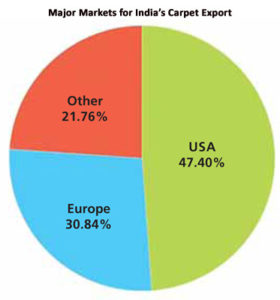 A global leader in handmade carpet
A global leader in handmade carpet
India is today a clear leader in the international handmade carpet market. India’s heritage of handmade carpet has been recognized worldwide with a commending share in global exports, for its subtle elegance, eco friendliness and exquisite vibrant colour craftsmanship with a human touch.
Key markets and potential
India is exporting to more than 70 countries in the world, mainly to the US, Germany, Canada, UK, Australia, South Africa, France, Italy, Brazil etc. India has also started exporting to China. USA with 47.40 per cent share followed by Europe with 30.84 per cent share (Germany, UK, France being leading importers) are traditionally the biggest and established markets for Indian carpets. Europe however, seems to be stagnant today, with no sign of revival in demand, forcing exporters to find new markets. Scandinavian counties have an unexplored potential to be tapped. CEPC has also identified some thrust countries for this purpose.
Despite holding the biggest share in the Indian carpet exports, USA still promises some growth. It is a dynamic market where economy is doing well. American consumers simply love handmade Indian rugs. Latin American countries like Brazil, Chile, Argentina and Colombia have a large unexplored potential. Brazil in particular has large population and good demand, but the import duties need to become more rational.
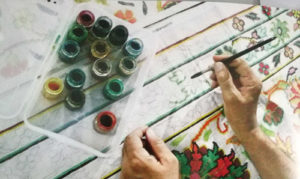 The Art & Craft manufacturing Process
The Art & Craft manufacturing Process
Once the dyed yarn is ready, the designers create carpet designs either by hand or on a CAD. These designs are the reference point for production of all types of carpets. A warp frame is constructed for hand-knotted carpets. Hand-knotted carpets made from silk and wool are the most exquisite in these carpets is skillfully tied by the weaver under strict guidance of the master weaver. Pre woven fabric is stretched on a tufting loom to produce Tufted Carpets. Tufted Carpets are relatively easier to produce as the yarn is tufted by a tufting tool at high frequency. Hand-woven carpets are directly woven on handloom like fabrics.
Yarns used for all types of carpets are dyed or prefinished natural yarns. Post weaving, handmade carpets go through the process of latex fixing, backing, washing, sheering, finishing and inspection before they are ready for export shipments. India offers one of the largest varieties of designs, weaves, structures and processes for handmade carpets. The range consists of Hand-knotted, Handtufted and Hand-woven carpets, Area Rugs, Kilims and Durries, all of which follow a unique manufacturing process of their own.
Training and Skill Development
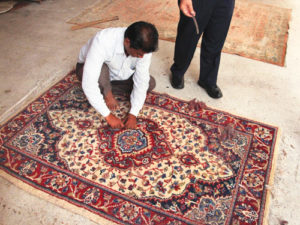 With high socioeconomic importance, the hand-made carpets is constantly developing and sustaining its human and material sources, necessary for its long term survival. Foresighted lyrealising this, CEPC, with Indian Government ensures and supports every effort towards an eco-friendly and sustainable the support of the production process.
With high socioeconomic importance, the hand-made carpets is constantly developing and sustaining its human and material sources, necessary for its long term survival. Foresighted lyrealising this, CEPC, with Indian Government ensures and supports every effort towards an eco-friendly and sustainable the support of the production process.
This includes, several skill development programmes for working artisans and craftsmen, attracting managerial talent and educate them in modern production techniques, bringing in modern designing concepts on CAD, initiating efforts to set up regional common effluent treatment plants, improving quality and consistency management infrastructure to name a few.
CEPC trains women artisans in Jayapur village and its surrounding areas for carpet weaving. Apart from providing a free trainer, necessary training infrastructure and required raw material, every trainee also gets a monthly stipend from CEPC. Trained weavers are then linked with major carpet export houses, who provide them weaving assignment on job work basis. These women take yarn home and weave at home in their spare time, thus adding to their incomes. This initiative is helping the industry make-up, at least partially, for the shortage of skilled weavers, which has been its major worry in recent years. Initiatives on skill development and marketing:
Indian Handmade Carpet Industry is concentrating strongly on Skill Development and has undertaking big marketing initiatives. Carpet Industry has initiated and opened 120 Carpet Weaving Training Centres till date in Jayapura, Bhadoshi & Mirzapur, imparted training to around 1956 artisans especially women. In Jauapur Village 8 training batches have been completed where 96 artisans were trained. Council has also ran 6 Centres in Rajasthan, 3 Centre in UP, 3 Centres in Haryana, 2 Centres in Jharkhand, 2 Centres in Orissa, 2 Centres in Chattisgarh to train 360 weavers. Council is further going to open 8 Training Centres in Bihar, Jharkhand, Andhra Pradesh, Sikkim & Manipur to train 160 weavers. Council is also opening five Design Training Centers in different craft areas. Handmade Carpet Industry undertakes various domestic and international marketing initiatives for helping small and medium manufacturers/exporters for showcasing their products to the overseas buyers.
Under the “Sab Ka Saath Sab Ka Vikas” initiative of Ministry of Textiles, Government of India, CEPC also provides carpet weaving looms and work sheds to these trained artisans offirst three batches of Jayapur Village, to make them selfsufficient entrepreneurs.




